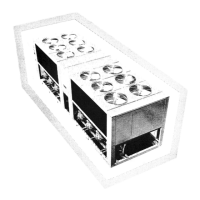Controls, Start-Up, Operation,
Service, and Troubleshooting
SAFETY CONSIDERATIONS
Installing, starting up, and servicing this equipment can
be hazardous due to system pressures, electrical compo-
nents, and equipment location (roof, elevated structures, etc.).
Only trained, qualified installers and service mechanics should
install, start up, and service this equipment.
When working on this equipment, observe precautions in
the literature, and on tags, stickers, and labels attached to the
equipment, and any other safety precautions that apply. Fol-
low all safety codes. Wear safety glasses and work gloves.
Use care in handling, rigging, and setting this equipment,
and in handling all electrical components.
Electrical shock can cause personal injury and death.
Shut off all power to this equipment during installation
and service. There may be more than one disconnect
switch. Tag all disconnect locations to alert others not
to restore power until work is completed.
This unit uses a microprocessor-based electronic con-
trol system. Do not use jumpers or other tools to short
out components, or to bypass or otherwise depart from
recommended procedures. Any short-to-ground of the
control board or accompanying wiring may destroy the
electronic modules or electrical components.
To prevent potential damage to heat exchanger tubes al-
ways run fluid through heat exchangers when adding or
removing refrigerant charge. Use appropriate brine so-
lutions in cooler and condenser fluid loops to prevent
the freezing of heat exchangers when the equipment is
exposed to temperatures below 32 F (0° C).
DO NOT VENT refrigerant relief valves within a build-
ing. Outlet from relief valves must be vented outdoors
in accordance with the latest edition of ANSI/ASHRAE
(American National Standards Institute/American Soci-
ety of Heating, Refrigeration and Air Conditioning En-
gineers) 15 (Safety Code for Mechanical Refrigeration).
The accumulation of refrigerant in an enclosed space
can displace oxygen and cause asphyxiation. Provide ad-
equate ventilation in enclosed or low overhead areas.
Inhalation of high concentrations of vapor is harmful
and may cause heart irregularities, unconsciousness or
death. Misuse can be fatal. Vapor is heavier than air and
reduces the amount of oxygen available for breathing.
Product causes eye and skin irritation. Decomposition
products are hazardous.
DO NOT attempt to unbraze factory joints when ser-
vicing this equipment. Compressor oil is flammable and
there is no way to detect how much oil may be in any
of the refrigerant lines. Cut lines with a tubing cutter as
required when performing service. Use a pan to catch
any oil that may come out of the lines and as a gage for
how much oil to add to system. DO NOT re-use com-
pressor oil.
CONTENTS
Page
SAFETY CONSIDERATIONS ...................1
GENERAL ...................................2
INTRODUCTION ..............................2
MAJOR SYSTEM COMPONENTS ............3-10
General ......................................3
Main Base Board (MBB) ......................3
Expansion Valve (EXV) Board .................3
Compressor Expansion Board (CXB) ..........3
Scrolling Marquee Display ....................3
Energy Management Module (EMM) ...........3
Enable/Off/Remote Contact Switch ............3
Emergency On/Off Switch ....................3
Reset Button ................................3
Board Address ...............................3
Control Module Communication ..............3
Carrier Comfort Network Interface ............3
OPERATING DATA .........................11-46
Sensors ....................................11
• T1 — COOLER LEAVING FLUID SENSOR
• T2 — COOLER ENTERING FLUID SENSOR
• T3,T4 — SATURATED CONDENSING
TEMPERATURE SENSORS
• T5,T6 — COOLER SUCTION TEMPERATURE
SENSORS
• T7,T8 — COMPRESSOR SUCTION GAS
TEMPERATURE SENSORS
• T9 — OUTDOOR-AIR TEMPERATURE SENSOR
• T10 — REMOTE SPACE TEMPERATURE SENSOR
Thermostatic Expansion Valves (TXV) ........15
Compressor Protection Control System
(CPCS) or Control Relay (CR) ..............15
Compressor Current Protection Board
(CGF) and Control Relay (CR) ..............15
Electronic Expansion Valve (EXV) ............16
Energy Management Module .................16
Capacity Control ............................16
• MINUTES LEFT FOR START
• MINUTES OFF TIME
• LOADING SEQUENCE
• LEAD/LAG DETERMINATION
• CAPACITY SEQUENCE DETERMINATION
• CAPACITY CONTROL OVERRIDES
30GTN,GTR040-420
Air-Cooled Reciprocating Liquid Chillers
with
ComfortLink™
Controls
50/60 Hz
Manufacturer reserves the right to discontinue, or change at any time, specifications or designs without notice and without incurring obligations.
Book 2
Tab 5c
PC 903 Catalog No. 533-099 Printed in U.S.A. Form 30GTN-1T Pg 1 5-99 Replaces: New












